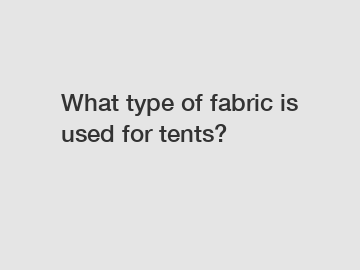What type of fabric is used for tents?
What Type of Fabric is Used for Tents?
When it comes to choosing a tent, one of the most important considerations is the type of fabric used. The fabric plays a crucial role in determining the durability, functionality, and overall performance of the tent. Different types of fabrics offer varying levels of weather resistance, breathability, and weight. In this article, we will explore the different types of fabrics commonly used for tents, their characteristics, and the factors to consider when choosing the ideal fabric for your camping needs.
Polyester: Lightweight and Water-Resistant.

One of the most commonly used fabrics for tents is polyester. Polyester is a synthetic material known for its lightweight nature, making it ideal for backpackers and hikers who require a lightweight and easily portable tent. It is also water-resistant, which is a crucial factor in ensuring that your tent remains dry during rainy conditions. Polyester tents are relatively affordable and offer good value for money in terms of their durability and resistance to UV rays.
Canvas: Durable and Breathable.
Canvas is a natural fabric that has been used for making tents for centuries. It is made from cotton or a blend of cotton and synthetic fibers, offering a balance between durability and breathability. Canvas tents are known for their exceptional durability, making them a popular choice for long-term camping or extreme weather conditions. However, they tend to be heavier compared to polyester tents and require more effort to set up and pack away.
Nylon: Lightweight and Weather-Resistant.
Nylon is another popular choice for tent fabrics, particularly for lightweight backpacking tents. It is a synthetic fabric that offers excellent strength-to-weight ratio and weather resistance. Nylon tents are known for their durability and ability to withstand harsh weather conditions. They are also relatively affordable, making them a great option for budget-conscious campers. However, nylon tents are less breathable compared to canvas or polyester tents, which can lead to condensation issues in certain weather conditions.
Poly-Cotton: The Best of Both Worlds.
Poly-cotton, as the name suggests, is a blend of polyester and cotton. This combination offers the best of both worlds – the durability and breathability of cotton, and the water-resistance of polyester. Poly-cotton tents are highly versatile and suitable for a wide range of camping environments. They are durable, offer good breathability, and provide adequate protection from rain. However, they are usually heavier and more expensive compared to tents made from other fabrics.
Factors to Consider When Choosing Tent Fabric.
When selecting a tent fabric, several factors need to be taken into consideration:
1. Location and Climate: Consider the weather conditions and the climate of the camping destination. If you frequently camp in areas with heavy rainfall, a waterproof fabric like polyester or poly-cotton would be a better choice. For camping in hot and humid conditions, prioritize breathability.
2. Weight and Portability: If you plan on backpacking or hiking, the weight and portability of the tent are crucial factors to consider. Lightweight fabrics like polyester and nylon are more suitable for these activities.
3. Durability: Evaluate the durability of the fabric by considering factors like the denier rating (thickness) and reinforcement features. Canvas tents are renowned for their durability, while polyester and nylon are also known for their strength.
4. Budget: Determine your budget and consider the cost of different tent fabrics. Polyester tents are generally more affordable, while canvas and poly-cotton tents tend to be on the higher end of the price spectrum.
Conclusion.
The type of fabric used for tents has a significant impact on the overall performance and functionality of the tent. Polyester, canvas, nylon, and poly-cotton are among the most commonly used fabrics in tent construction, each offering different benefits and limitations. When choosing a tent fabric, consider factors such as weather resistance, breathability, weight, durability, and budget. By carefully evaluating these factors, you can select a tent fabric that meets your camping needs and ensures a comfortable and enjoyable outdoor experience. For further assistance or inquiries, please feel free to reach out to us at [Contact Us].
If you are looking for more details, kindly visit eyelet mesh fabric, athletic mesh fabric supplier, large hole mesh fabric.

Comments